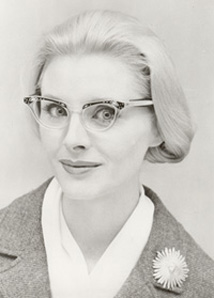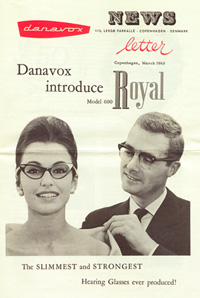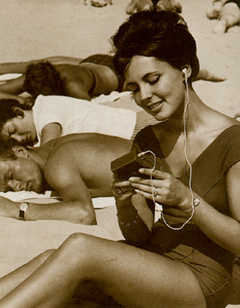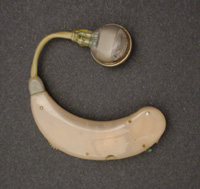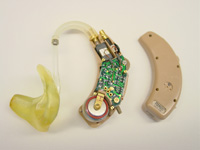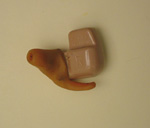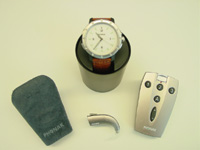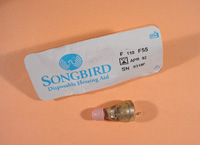Concealed Hearing Devices of the 20th Century
The development of the transistor in the late 1940s enabled once-cumbersome hearing aids to be streamlined into single units practical for everyday use. What could be more practical than incorporating a hearing aid – or two – into eyeglasses? The first eyeglass model was introduced in the United States in 1954. By 1959, they accounted for approximately 50% of the market.
In 1952, the hearing aid was the first commercially made product to employ the transistor. The transistor radio was not available to the public until 1954.
© Courtesy of Beltone Electronics Corporation |
© Reprinted with permission from Arnoud Beem |
| Beltone “Classic,” 1960 | Danavox “Royal,” 1960 |
|---|---|
| Beltone introduced their first eyeglass aid in September 1955, the “;Hear-N-See” model. The “Classic” was introduced in 1960 and came with from three to five transistors. | Danavox first introduced an eyeglass hearing aid in 1955, the “Lunettes” (Model 559). The Model 600 “Royal” debuted in 1960. |
| Sonotone Model 400, 1957 | |
| This was Sonotone’s first eyeglass hearing aid model. It featured four transistors and automatic gain control (AGC). |
| Acousticon A-100, 1947 | |
|---|---|
| This one-piece vacuum tube hearing aid from Acousticon came with an optional radio pickup accessory called the “Radion.” | |
© Reprinted with permission from Arnoud Beem |
“The most important single development which has overcome the handicap of deafness has been the modern hearing aid.”
— Moe Bergman, Ed.D., 1956
The behind-the-ear hearing aid (BTE), first introduced in the late 1950s, was an ideal means of concealing a hearing aid – it was worn discreetly behind the ear and underneath the hair, with a custom-made earmold. The BTE incorporated all components of a hearing aid into a single, streamlined unit including the batteries. Within a few years of the introduction of the BTE, the BTE overtook the eyeglass hearing aid model in hearing aid sales in the United States.
|
|
In-the-ear (ITE) and in the canal (ITC) hearing aids were introduced in the late 1950s and early 1960s and even smaller completely-in-the-canal (CIC) hearing aids entered the market in the 1980s and 1990s. These models provided more opportunity for concealment with acoustic benefit for many users.
By 1996, hearing devices housing all hearing aid components completely within a custom-made earmold represented about 80% of all United States hearing aid sales. New features such as directional microphones, flexible digital programming and adaptive filtering provide users with the best of both worlds – an effective hearing aid that is also virtually unnoticeable.
Along with enhanced, customized performance, digital technology has introduced an additional hearing aid component: a remote-control unit used to select from among pre-programmed sound processing options. These units, usually designed to be tucked into a pocket, are also available in a working wristwatch model. In contrast to similar devices of the 1950s, the emphasis is on convenience and performance, rather than concealment.
In the 1990s, manufacturers began to design hearing aids to be noticed as jeweled adornments and works of art. Hearing aids are made with stainless steel, brightly colored casings, and even encrusted with semi-precious stones.
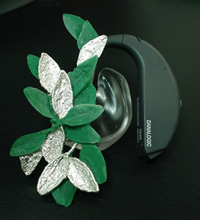 |
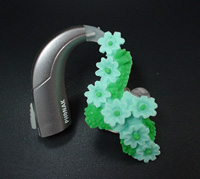 |
Some hearing aids now feature flowers, leaves, and abstract designs. |
|
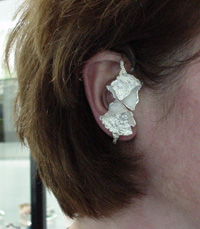 |
 |
Above images © Laboratorium Formaat/Petra Spigt and Annek Brouwer |
|
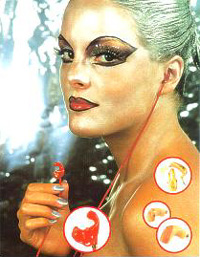 |
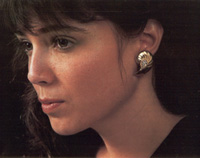 |
Above images courtesy of Nikosonic |
|
| Phonak BTE Colored Casings |  |
|---|---|
| BTE casings are available in a variety of bright colors as shown in this image. |
Earmolds are also available in many colors and with whimsical decoration such as polka dots and frogs.
 |
 |
 |
© Laboratorium Formaat/Petra Spigt and Annek Brouwer |
© Reprinted with permission from Arnoud Beem |
© Laboratorium Formaat/Petra Spigt and Annek Brouwer |


